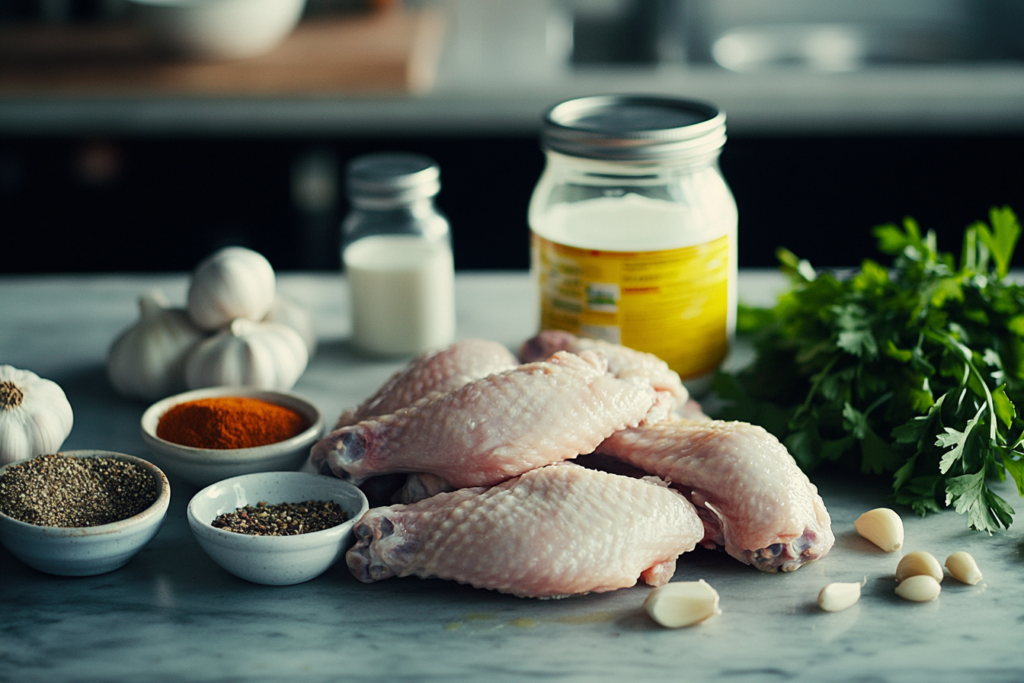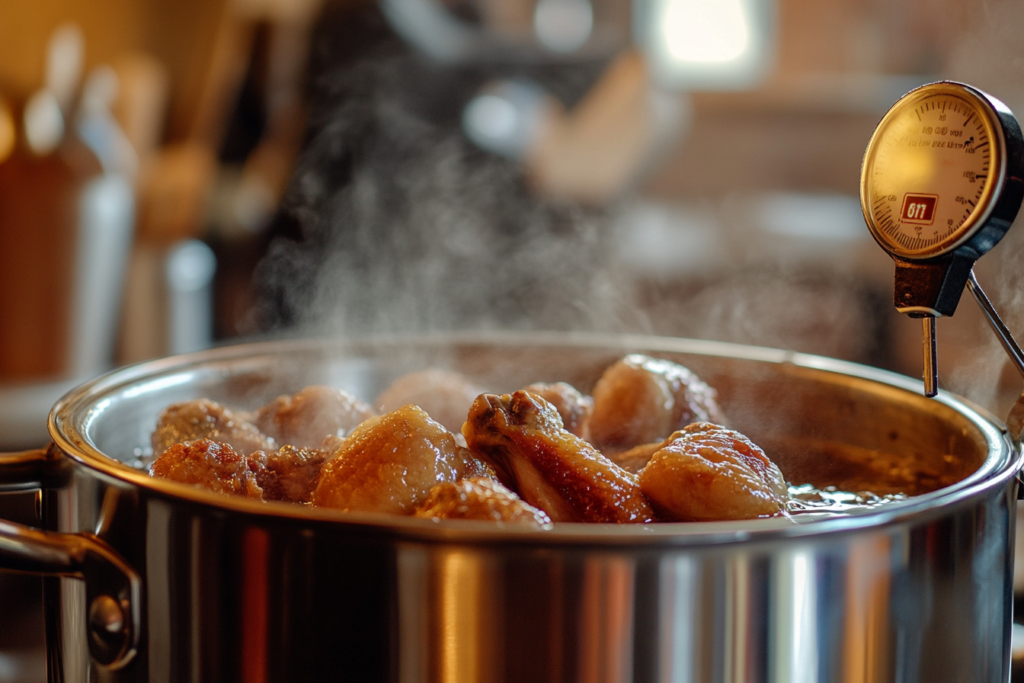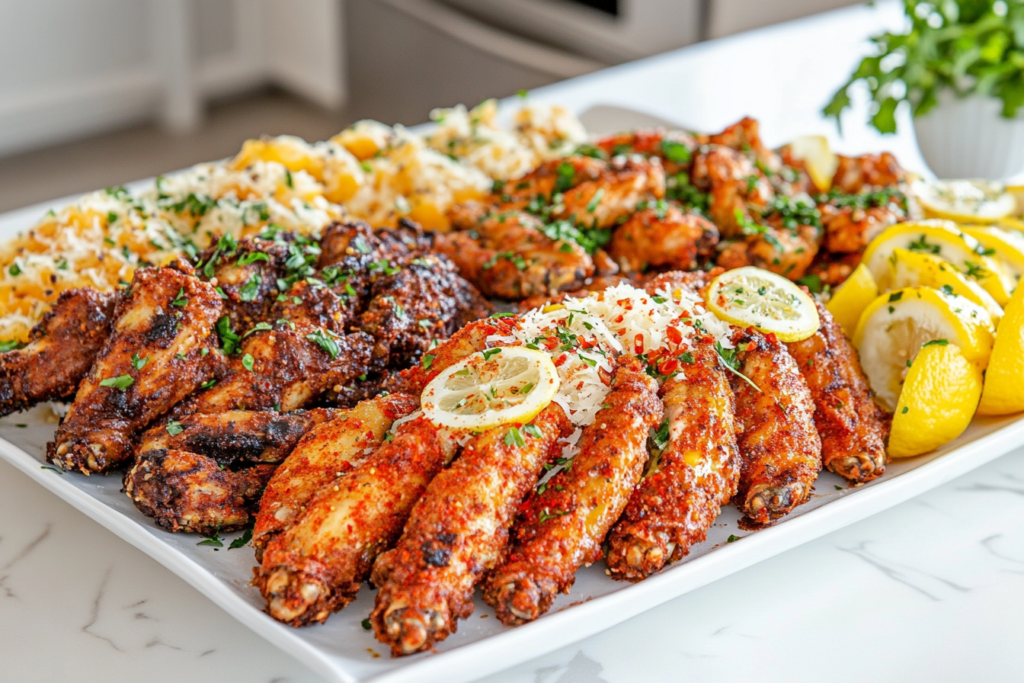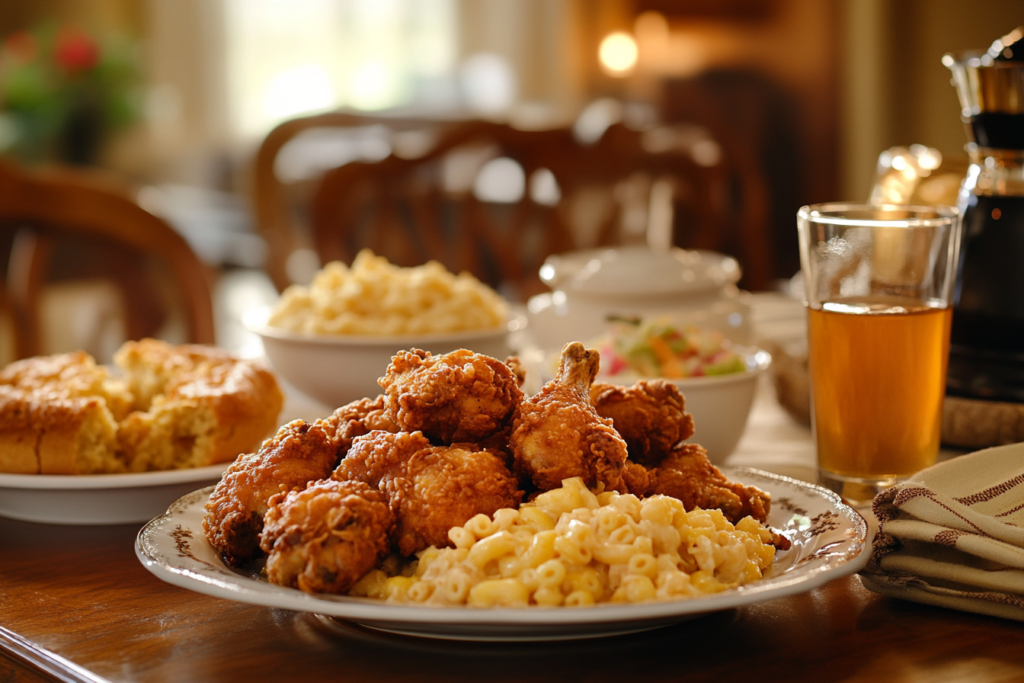Introduction
Turkey wings are a beloved delicacy, especially when fried to golden-brown perfection. They offer a tantalizing combination of juicy, tender meat encased in a crispy, flavorful coating. Whether you’re serving them as a snack, appetizer, or main course, fried turkey wings never fail to impress. Known for their versatility and ability to take on a wide range of seasonings, these wings are a hit at gatherings, game days, and family dinners.
The popularity of fried turkey wings stems from their rich flavor, ease of preparation, and suitability for various culinary traditions. In this guide, we’ll explore everything you need to know about frying turkey wings, from selecting the best ingredients to creating a perfectly crispy finish. So, if you’ve ever wondered how to elevate your cooking game with this irresistible dish, you’re in the right place.
Preparing the Turkey Wings
Proper preparation is key to achieving the best results when frying turkey wings. From selecting the freshest meat to seasoning and marinating, every step contributes to the final flavor and texture.

Choosing Fresh Turkey Wings
For the best results, always start with high-quality turkey wings. Look for wings that:
- Have firm, pinkish flesh with no discoloration.
- Feel cold to the touch and are stored at the correct temperature.
- Are free from unpleasant odors, which could indicate spoilage.
If possible, opt for organic or free-range turkey wings for a more flavorful and ethical choice.
Cleaning and Trimming the Wings
Proper cleaning is essential before frying:
- Rinse Thoroughly: Wash the wings under cold running water to remove any residue.
- Trim Excess Fat: Use kitchen shears to remove extra fat or loose skin.
- Pat Dry: Ensure the wings are completely dry with paper towels to allow the seasoning and coating to adhere better.
Marinating for Flavor
Marinating your turkey wings not only enhances flavor but also tenderizes the meat. Popular marinade ingredients include:
- Buttermilk: Helps tenderize and adds a tangy flavor.
- Spices: Garlic powder, paprika, cayenne, and thyme for depth of flavor.
- Citrus Juices: Lemon or lime juice for a bright, zesty kick.
Let the wings marinate for at least 2-4 hours, or overnight for maximum flavor.
Key Ingredients for Fried Turkey Wings
The secret to mouthwatering fried turkey wings lies in using the right ingredients. From the spice blend to the breading and oil, every component plays a crucial role in delivering flavor and texture.
Essential Ingredients
To prepare perfectly fried turkey wings, you’ll need the following basics:
- Turkey Wings: Fresh, cleaned, and trimmed wings as described earlier.
- Flour or Breading Mix: All-purpose flour is the foundation of the crispy coating, but pre-seasoned mixes can save time.
- Seasonings and Spices:
- Salt and Black Pepper: For basic seasoning.
- Garlic Powder and Onion Powder: Add depth to the flavor profile.
- Paprika or Smoked Paprika: Provides color and a mild smokiness.
- Cayenne Pepper: For a spicy kick. Adjust according to your heat tolerance.
- Eggs or Buttermilk: A binding agent that helps the breading stick.
- Oil for Frying: Use oils with high smoke points, such as peanut, vegetable, or canola oil, to ensure even cooking without burning.
Optional Additions for Enhanced Flavor
Looking to elevate your wings to the next level? Consider adding these ingredients:
- Cornstarch: Mix with flour for an extra crispy texture.
- Hot Sauce: Add to your buttermilk marinade for heat and tanginess.
- Fresh Herbs: Minced parsley, thyme, or rosemary for a gourmet touch.
- Grated Parmesan Cheese: Sprinkle over the wings after frying for an indulgent finish.
The Art of Frying Turkey Wings
Frying turkey wings is an art that combines technique, timing, and attention to detail. Follow these steps to achieve perfectly crispy wings every time.

Step-by-Step Frying Process
- Heat the Oil:
- Use a deep skillet, Dutch oven, or fryer.
- Fill the vessel with enough oil to submerge the wings, but don’t overfill to avoid spills.
- Heat the oil to 350–375°F (175–190°C) for optimal frying temperature.
- Coat the Wings:
- Dredge the marinated wings in seasoned flour or breading mix, ensuring an even coat.
- For extra crunch, dip the floured wings in beaten eggs or buttermilk, then re-dredge in flour.
- Fry in Batches:
- Carefully lower the wings into the hot oil, avoiding overcrowding, which can lower the oil temperature.
- Fry each batch for 10–12 minutes, turning occasionally, until the wings are golden brown and cooked through.
- Check for Doneness:
- Use a meat thermometer to ensure the internal temperature reaches at least 165°F (74°C).
- Remove the wings and let them rest on a wire rack or paper towel-lined plate to drain excess oil.
Tips for Perfect Results
- Maintain Oil Temperature: Use a thermometer to keep the oil consistently hot for even frying.
- Avoid Overcrowding: Fry in small batches to ensure the wings cook evenly and stay crispy.
- Let Them Rest: Allow the wings to rest for 3–5 minutes after frying; this helps the coating set.
Troubleshooting Common Issues
- Soggy Wings: Likely due to low oil temperature or overcrowding. Ensure the oil is hot enough and fry in smaller batches.
- Burnt Coating: The oil may be too hot. Keep an eye on the temperature and adjust the heat as necessary.
- Uneven Cooking: Ensure wings are evenly coated and fully submerged in oil during frying.
Popular Seasoning Variations
Fried turkey wings are incredibly versatile, making them the perfect canvas for experimenting with different seasoning styles. Whether you love a classic Southern flavor or crave bold and spicy combinations, there’s a seasoning variation for every palate.

Classic Southern-Style Seasoning
The hallmark of Southern fried turkey wings is a savory, well-seasoned crust with a hint of spice. To achieve this flavor:
- Use a blend of paprika, garlic powder, onion powder, and cayenne pepper for a kick.
- Add ground mustard and a dash of celery salt for extra depth.
- Marinate the wings in buttermilk for a tender, tangy finish before frying.
Spicy Cajun Wings
Cajun flavors bring boldness and heat to fried turkey wings. For this style:
- Season the wings with a Cajun spice mix featuring cayenne pepper, smoked paprika, thyme, and oregano.
- Add a pinch of chili flakes or habanero powder for extra spice.
- Pair with a refreshing ranch or blue cheese dip to balance the spice.
Garlic-Parmesan Coating
For a rich, savory twist, garlic-parmesan wings are a crowd favorite:
- Toss freshly fried wings in a mixture of melted butter, minced garlic, and grated Parmesan cheese.
- Add a sprinkle of parsley and a dash of black pepper for garnish.
- Serve hot for the ultimate indulgence.
Sweet and Spicy Honey Glaze
If you enjoy contrasting flavors, this sweet and spicy glaze is a must-try:
- Combine honey, soy sauce, garlic powder, and a touch of sriracha or chili paste.
- Toss the wings in the glaze after frying for a sticky, flavorful finish.
- Garnish with sesame seeds for an added crunch.
Lemon-Pepper Seasoning
Lemon-pepper wings are a bright and zesty option:
- Mix lemon zest, black pepper, salt, and a hint of garlic powder into your breading mixture.
- Alternatively, toss the fried wings in melted butter infused with lemon juice and pepper.
- Serve with lemon wedges for extra citrus zing.
Serving Suggestions and Pairings
Fried turkey wings are delicious on their own, but the right sides and accompaniments can elevate the meal into a full dining experience. From classic Southern staples to refreshing beverages, there’s no shortage of great pairings.

Perfect Side Dishes
- Mashed Potatoes and Gravy: Creamy mashed potatoes topped with savory turkey gravy create a comforting balance.
- Collard Greens: A traditional Southern side that adds a fresh, earthy element.
- Macaroni and Cheese: Rich, gooey, and cheesy mac and cheese complements the crispiness of the wings.
- Cornbread: Slightly sweet and crumbly, cornbread is a classic pairing for fried turkey wings.
- Coleslaw: The tangy crunch of coleslaw provides a refreshing contrast to the richness of the wings.
Dipping Sauces
The right sauce can take your fried turkey wings to the next level. Popular options include:
- Ranch Dressing: Creamy and cooling, ideal for spicy wings.
- Buffalo Sauce: Perfect for those who love an extra layer of heat.
- Honey Mustard: Sweet and tangy, great for milder wings.
- Barbecue Sauce: Smoky and sweet, a classic choice for any fried dish.
- Garlic Aioli: A rich and garlicky dip that pairs well with all seasoning styles.
Beverage Pairings
Pair your turkey wings with beverages that complement their flavor and texture:
- Iced Tea or Lemonade: Refreshing and slightly sweet, these drinks are perfect for balancing savory flavors.
- Beer: Light lagers, wheat beers, or IPAs enhance the crispy coating and seasoning of the wings.
- Soda: Classic cola or ginger ale provide a bubbly, sweet contrast.
Safety Tips for Frying
Frying turkey wings can be a rewarding experience, but it also requires caution to avoid accidents. From handling hot oil to ensuring proper ventilation, these tips will help you fry safely and confidently.
Choosing the Right Equipment
- Use a Heavy-Duty Pot or Fryer:
- A deep fryer or a heavy pot like a Dutch oven helps maintain even heat.
- Avoid shallow pans, as they increase the risk of oil spills.
- Invest in a Thermometer:
- Use a kitchen thermometer to monitor the oil temperature, keeping it steady at 350–375°F (175–190°C).
- Wear Protective Gear:
- Long sleeves and heat-resistant gloves can protect you from oil splatters.
- Use tongs or a slotted spoon to handle the wings safely.
Managing Hot Oil Safely
- Avoid Overfilling the Pot:
- Leave enough space for the wings and oil to expand.
- Overfilled pots can cause oil to spill when the wings are added.
- Lower Wings Slowly:
- Place the wings gently into the oil to prevent splashing.
- Never Leave Unattended:
- Stay close by and monitor the frying process to ensure everything goes smoothly.
- Keep a Fire Extinguisher Nearby:
- In case of an oil fire, use a fire extinguisher or cover the pot with a metal lid.
- Never use water to extinguish an oil fire—it can worsen the flames.
Post-Frying Cleanup
- Cool the Oil:
- Allow the oil to cool completely before disposing of it or straining it for future use.
- Wipe Surfaces:
- Clean countertops and stovetops immediately to remove any grease splatters.
- Ventilate the Kitchen:
- Open windows or use a range hood to remove lingering frying odors.
Common Mistakes to Avoid
Even seasoned cooks can make mistakes when frying turkey wings. Here’s how to steer clear of the most common pitfalls.
Not Drying the Wings Properly
Moisture on the wings can cause the oil to splatter dangerously and result in a soggy coating. Always pat the wings completely dry before seasoning and breading.
Inconsistent Oil Temperature
If the oil is too cool, the wings will absorb excess grease and turn out heavy and greasy. On the other hand, if the oil is too hot, the coating may burn before the meat is cooked through. Maintaining a steady temperature is essential for perfect results.
Overcrowding the Fryer
Adding too many wings at once can lower the oil temperature, leading to uneven cooking and soggy wings. Fry in small batches to ensure each wing is crispy and cooked to perfection.
Not Checking for Doneness
Undercooked wings can pose health risks, while overcooked wings may lose their juiciness. Always rely on a meat thermometer to confirm the internal temperature reaches at least 165°F (74°C).
Storing and Reheating Leftovers
Fried turkey wings are best enjoyed fresh, but leftovers can still be delicious if stored and reheated properly.
Storing Fried Turkey Wings
- Cool the Wings Completely:
- Allow the wings to cool to room temperature before storing them.
- Use Airtight Containers:
- Place the wings in a resealable bag or an airtight container to preserve freshness.
- Refrigeration:
- Store in the refrigerator for up to 3–4 days.
- Freezing:
- For longer storage, freeze the wings for up to 2 months. Wrap them in foil or freezer-safe bags to prevent freezer burn.
Reheating for Crispiness
Reheating fried turkey wings can be tricky, as you want to restore their crispiness. Here’s how:
- Oven Reheating:
- Preheat the oven to 375°F (190°C).
- Place the wings on a wire rack over a baking sheet to allow air circulation.
- Heat for 10–15 minutes or until crispy.
- Air Fryer Method:
- Preheat the air fryer to 375°F (190°C).
- Reheat the wings for 5–7 minutes, flipping them halfway through for even crispiness.
- Avoid Microwaving:
- Microwaving can make the wings soggy and unappetizing. Stick to the oven or air fryer for best results.
For those looking to expand their culinary repertoire with turkey dishes, explore the rich flavors of other turkey recipes available on our site. Pair your fried turkey wings with a comforting smothered turkey wings recipe for a delightful variation. For a healthier twist, consider trying the smoked turkey wings recipe, which captures a perfect balance of smokiness and tenderness. Don’t miss out on our easy turkey wings recipe that simplifies the preparation process while retaining all the classic flavors you love. These recipes are perfect companions to enhance your knowledge and create a variety of turkey dishes for any occasion.
FAQ
How long does it take to fry turkey wings?
It typically takes 10–12 minutes to fry turkey wings, depending on their size and thickness. Ensure the oil is heated to 350–375°F (175–190°C), and always check that the internal temperature of the wings reaches 165°F (74°C) for safe consumption.
Can you fry turkey like chicken?
Yes, turkey can be fried much like chicken. However, because turkey has a denser texture and larger pieces, it may require slightly longer cooking times. The same techniques, such as breading, seasoning, and frying in hot oil, work perfectly for turkey wings.
How to get crispy turkey skin when frying?
For crispy skin, pat the wings dry before breading to remove moisture. Use a flour or cornstarch mixture for coating, and ensure the oil stays at a consistent high temperature. Fry in small batches to prevent overcrowding, which can make the skin soggy.
Why do you soak turkey wings in vinegar?
Soaking turkey wings in vinegar helps tenderize the meat, remove impurities, and eliminate any gamey odors. Vinegar also acts as a mild flavor enhancer, giving the wings a fresher, cleaner taste. Rinse thoroughly after soaking to balance the acidity.
Conclusion
Fried turkey wings are a versatile and flavorful dish that can elevate any meal. Whether you’re serving them at a party, family dinner, or as a quick snack, their crispy exterior and juicy interior are sure to satisfy. By following the steps in this guide, you can master the art of frying turkey wings, customize them with your favorite seasonings, and create a dish that’s uniquely yours. From preparation to plating, every bite will be worth the effort

